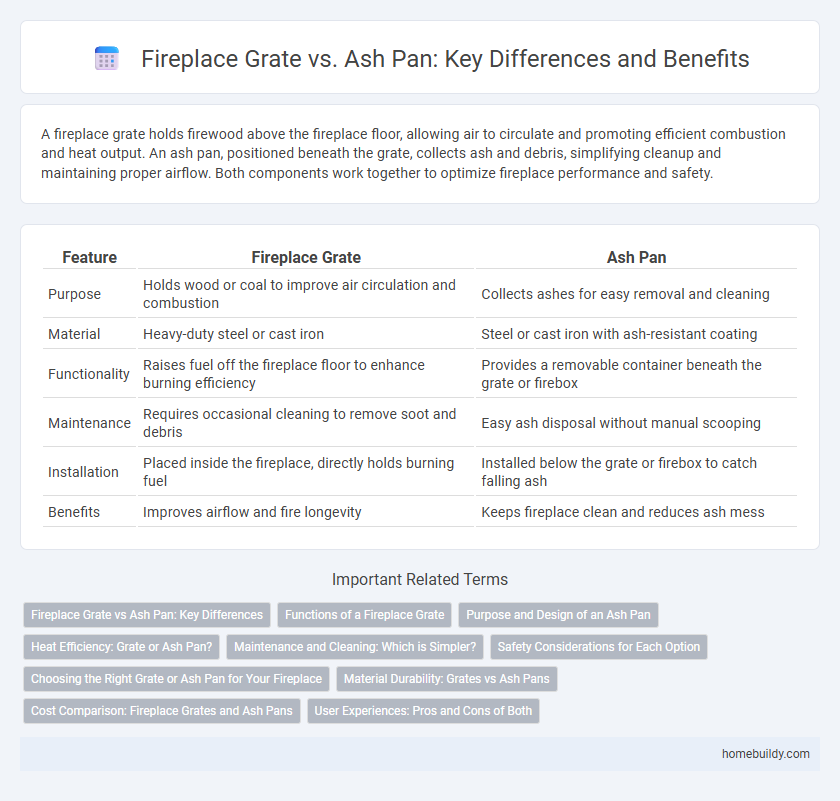A fireplace grate holds firewood above the fireplace floor, allowing air to circulate and promoting efficient combustion and heat output. An ash pan, positioned beneath the grate, collects ash and debris, simplifying cleanup and maintaining proper airflow. Both components work together to optimize fireplace performance and safety.
Table of Comparison
| Feature | Fireplace Grate | Ash Pan |
|---|---|---|
| Purpose | Holds wood or coal to improve air circulation and combustion | Collects ashes for easy removal and cleaning |
| Material | Heavy-duty steel or cast iron | Steel or cast iron with ash-resistant coating |
| Functionality | Raises fuel off the fireplace floor to enhance burning efficiency | Provides a removable container beneath the grate or firebox |
| Maintenance | Requires occasional cleaning to remove soot and debris | Easy ash disposal without manual scooping |
| Installation | Placed inside the fireplace, directly holds burning fuel | Installed below the grate or firebox to catch falling ash |
| Benefits | Improves airflow and fire longevity | Keeps fireplace clean and reduces ash mess |
Fireplace Grate vs Ash Pan: Key Differences
A fireplace grate is designed to elevate logs, allowing better airflow for efficient combustion and heat distribution, while an ash pan collects ashes and debris for easy cleanup. Grates improve burning performance by holding wood off the fireplace floor, whereas ash pans serve as removable trays positioned beneath the grate or firebox. Understanding the distinct roles of a fireplace grate versus an ash pan helps optimize fireplace maintenance and maximize heating efficiency.
Functions of a Fireplace Grate
A fireplace grate elevates wood or coal, enhancing airflow for more efficient combustion and heat distribution compared to an ash pan, which primarily collects debris. This airflow optimization prevents smoldering and promotes a hotter, cleaner fire. Unlike ash pans, fireplace grates also facilitate easier fire management by keeping fuel off the fireplace floor.
Purpose and Design of an Ash Pan
An ash pan is designed to collect and contain ashes falling from the fire, making cleanup more efficient and maintaining airflow beneath the fire. Unlike a fireplace grate, which supports burning logs and promotes air circulation for combustion, the ash pan fits directly beneath the grate to catch debris without interfering with the fire. Its sturdy, removable metal construction ensures safe and hygienic disposal of ash residue while preserving the overall functionality of the fireplace.
Heat Efficiency: Grate or Ash Pan?
A fireplace grate enhances heat efficiency by elevating the firewood, allowing better airflow and more complete combustion, which generates greater heat output. In contrast, an ash pan collects ashes beneath the fire but does not improve airflow, resulting in lower heat efficiency. Choosing a grate over an ash pan maximizes heat retention and combustion performance in a wood-burning fireplace.
Maintenance and Cleaning: Which is Simpler?
A fireplace grate requires regular ash removal and can be easily cleaned by shaking or brushing off debris, making maintenance straightforward. An ash pan collects ashes beneath the grate, allowing for quick removal but demands careful handling to avoid spills during emptying. Overall, fireplace grates offer simpler cleaning routines, while ash pans provide a neater but slightly more involved maintenance process.
Safety Considerations for Each Option
Fireplace grates enhance safety by elevating logs for better airflow, reducing smoke buildup, and preventing embers from spilling directly onto the hearth, which minimizes fire hazards. Ash pans collect falling ash beneath the grate, allowing safer and cleaner removal of ashes without dispersing dust or sparks that could ignite nearby materials. Choosing a fireplace grate with an ash pan integration provides optimal safety by combining efficient combustion support with controlled ash disposal.
Choosing the Right Grate or Ash Pan for Your Fireplace
Selecting the right fireplace grate or ash pan depends on your fireplace type, fuel choice, and maintenance preferences. A sturdy cast iron grate improves airflow, enhancing combustion and heat output for wood-burning fireplaces, while an ash pan simplifies cleaning by collecting debris and ash in one removable container. Prioritize durability, size compatibility, and ease of ash disposal to optimize fireplace efficiency and reduce maintenance time.
Material Durability: Grates vs Ash Pans
Fireplace grates are typically made from heavy-duty cast iron or steel, ensuring they withstand high temperatures and prolonged use without warping or cracking. Ash pans, often constructed from thinner sheet metal or aluminum, prioritize lightweight design but may be more prone to corrosion and damage over time. The thicker, more robust materials of grates offer superior durability compared to the lighter, less durable materials commonly used in ash pans.
Cost Comparison: Fireplace Grates and Ash Pans
Fireplace grates typically cost between $30 and $150 depending on size and material, offering a durable platform for efficient wood burning. Ash pans generally range from $40 to $100 and provide ease of cleaning by collecting ash in a removable tray. Choosing between the two depends on budget considerations and desired functionality, with grates often being a more long-term investment and ash pans favored for maintenance convenience.
User Experiences: Pros and Cons of Both
Fireplace grates improve airflow and fuel efficiency by elevating logs, producing longer-lasting, cleaner burns, but they require regular cleaning and can be less effective with small ashes. Ash pans simplify cleanup by collecting ashes in a removable tray, reducing mess and effort, yet they may restrict airflow, leading to slower burns and less effective heat distribution. Users often choose grates for enhanced combustion and warmth, while ash pans appeal to those prioritizing easy maintenance.
Fireplace grate vs Ash pan Infographic

 homebuildy.com
homebuildy.com